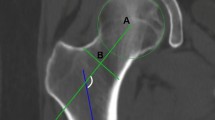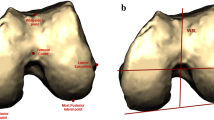Abstract
Purpose
To show the differences in lateral and anterior femoral shaft bowing (FSB) between radiographic and computed tomography (CT) images and to assess whether FSB is associated with various predictive factors in women with knee osteoarthritis (OA) using CT images.
Methods
We enrolled 135 Japanese women with medial compartment knee OA. Lateral and anterior FSB were measured by radiography and reconstructed CT. Age, body mass index (BMI), femorotibial angle (FTA), femoral length, and lumbar spine and femoral neck bone mineral density (BMD) were set as predictive factors for progression of knee OA. We compared predictive factors in the lateral FSB group having lateral angulations of >5° with those in the nonbowing group and compared predictive factors in the anterior FSB group having anterior angulations of >11° with those in the nonbowing group. Binomial logistic regression modeling was applied to determine independent predictors of both FSB.
Results
There were significant differences in both FSB between the radiographic and reconstructed CT images (P = 0.005 and P = 0.047, respectively). In binomial logistic regression analyses for lateral FSB on CT, age, BMI, and lumbar spine BMD were significant predictors, with odds ratios of 1.16, 1.22, and 0.03, respectively; for anterior FSB on CT, age was a significant predictor, with an odds ratio of 1.06.
Conclusions
It is preferable to measure both FSB on reconstructed CT when planning reconstructive knee surgeries. Age, BMI, and lumbar spine BMD were predictors of lateral FSB progression, and age was a predictor of anterior FSB progression.
Level of evidence Level III.


Similar content being viewed by others
References
Demes B (2007) In vivo bone strain and bone functional adaptation. Am J Phys Anthropol 133:717–722
Mullaji AB, Marawar SV, Mittal V (2009) A comparison of coronal plane axial femoral relationships in Asian patients with varus osteoarthritic knees and healthy knees. J Arthroplast 24:861–867
Lasam MP, Lee KJ, Chang CB, Kang YG, Kim TK (2013) Femoral lateral bowing and varus condylar orientation are prevalent and affect axial alignment of TKA in Koreans. Clin Orthop Relat Res 471:1472–1483
Matsumoto T, Hashimura M, Takayama K, Ishida K, Kawakami Y, Matsuzaki T et al (2015) A radiographic analysis of alignment of the lower extremities: initiation and progression of varus-type knee osteoarthritis. Osteoarthr Cartil 23:217–223
Gilbert BM (1976) Anterior femoral curvature: its probably basis and utility as a criterion of racial assessment. Am J Phys Anthropol 45:601–604
Ballard ME (1999) Anterior femoral curvature revisited: race assessment from the femur. J Forensic Sci 44:700–707
Egol KA, Chang EY, Cvitkovic J, Kummer FJ, Koval KJ (2004) Mismatch of current intramedullary nails with the anterior bow of the femur. J Orthop Trauma 18:410–415
Tang WM, Chiu KY, Kwan MF, Ng TP, Yau WP (2005) Sagittal bowing of the distal femur in Chinese patients who require total knee arthroplasty. J Orthop Res 23:41–45
Harma A, Germen B, Karakas HM, Elmali N, Inan M (2005) The comparison of femoral curves and curves of contemporary intramedullary nails. Surg Radiol Anat 27:502–506
Karakaş HM, Harma A (2008) Femoral shaft bowing with age: a digital radiological study of Anatolian Caucasian adults. Diagn Interv Radiol 14:29–32
Huang TW, Hsu WH, Peng KT, Hsu RW (2011) Total knee replacement in patients with significant femoral bowing in the coronal plane: a comparison of conventional and computer-assisted surgery in an Asian population. J Bone Jt Surg (Br) 93:345–350
Soh HH, Chua IT, Kwek EB (2015) Atypical fractures of the femur: effect of anterolateral bowing of the femur on fracture location. Arch Orthop Trauma Surg 135:1485–1490
Yau WP, Chiu KY, Tang WM, Ng TP (2007) Coronal bowing of the femur and tibia in Chinese: its incidence and effects on total knee arthroplasty planning. J Orthop Surg (Hong Kong) 15:32–36
Yehyawi TM, Callaghan JJ, Pedersen DR, O’Rourke MR, Liu SS (2007) Variances in sagittal femoral shaft bowing in patients undergoing TKA. Clin Orthop Relat Res 464:99–104
Kellgren JH, Lawrence JS (1957) Radiological assessment of osteo-arthrosis. Ann Rheum Dis 16:494–502
Ahlbäck S (1968) Osteoarthrosis of the knee: a radiographic investigation. Acta Radiol Diagn (Stockh) 277(Suppl):7–72
Kobayashi H, Akamatsu Y, Kumagai K, Kusayama Y, Ishigatsubo R, Muramatsu S et al (2014) The surgical epicondylar axis is a consistent reference of the distal femur in the coronal and axial planes. Knee Surg Sports Traumatol Arthrosc 22:2947–2953
Hunter DJ, Niu J, Felson DT, Harvey WF, Gross KD, McCree P et al (2007) Knee alignment does not predict incident osteoarthritis: the Framingham Osteoarthritis Study. Arthritis Rheum 56:1212–1218
Harma A, Karakas HM (2007) Determination of sex from the femur in Anatolian Caucasians: a digital radiological study. J Forensic Leg Med 14:190–194
Pfitzner T, von Roth P, Perka C, Matziolis G (2014) Intramedullary control of distal femoral resection results in precise coronal alignment in TKA. Arch Orthop Trauma Surg 134:459–465
Işcan MY, Shihai D (1995) Sexual dimorphism in the Chinese femur. Forensic Sci Int 74:79–87
Han CD, Lee YH, Yang KH, Yang IH, Lee WS, Park YJ, Park KK (2012) Predicting proximal femur rotation by morphological analyses using translucent 3-dimensional computed tomography. Arch Orthop Trauma Surg 132:1747–1752
Author information
Authors and Affiliations
Corresponding author
Ethics declarations
Conflict of interest
The authors have no conflicts of interest to declare.
Rights and permissions
About this article
Cite this article
Akamatsu, Y., Kobayashi, H., Kusayama, Y. et al. Femoral shaft bowing in the coronal and sagittal planes on reconstructed computed tomography in women with medial compartment knee osteoarthritis: a comparison with radiograph and its predictive factors. Arch Orthop Trauma Surg 136, 1227–1232 (2016). https://doi.org/10.1007/s00402-016-2519-4
Received:
Published:
Issue Date:
DOI: https://doi.org/10.1007/s00402-016-2519-4




